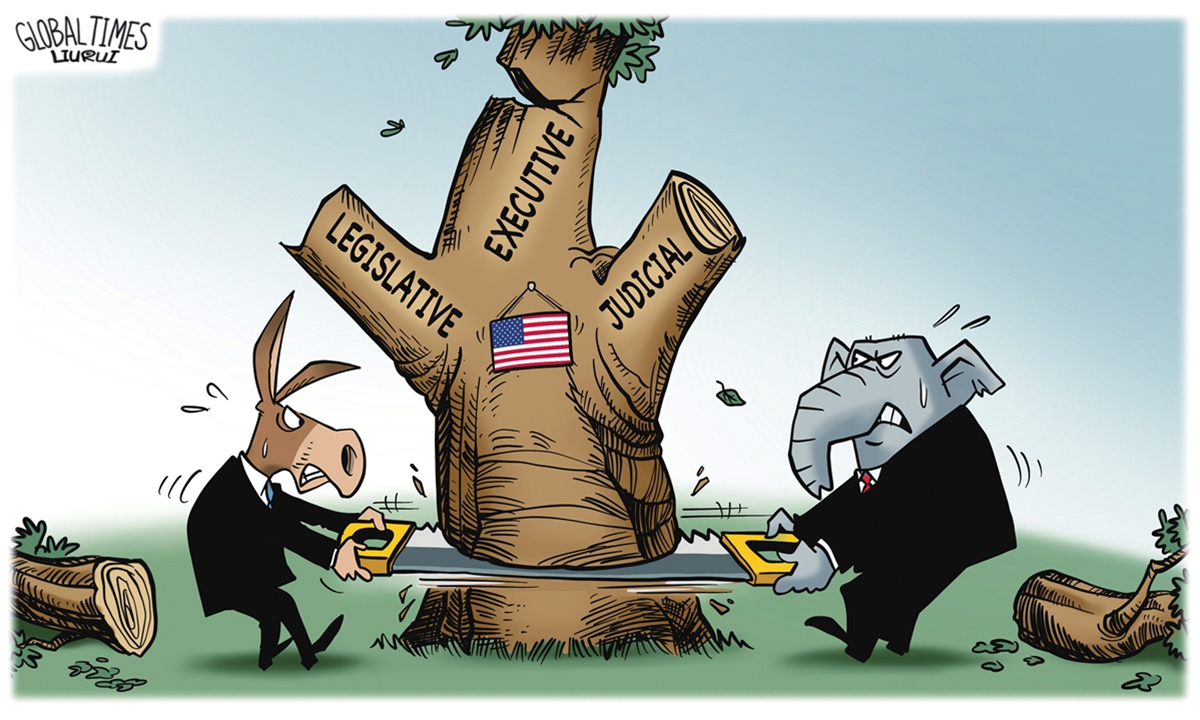
Illustration: Liu Rui/GT
Originally designed to prevent abuse of power, the mechanism of checks and balances among the legislative, executive and judicial branches of the US government was once regarded as a prime example of the modern democratic system. In recent years, however, the US might have found itself struggling with this political design that it was so proud of. Divided by deep partisan fighting, each of the three branches is desperate to check and curtail every proposal and act of the other branches that is not initiated by its own party, leaving the idea of balance as an impossible myth.
The epitome of this division between and dysfunction of the executive and legislative branches came as the relationship between the Republican government led by former president Donald Trump and the Congress under the leadership of Democratic House Speaker Nancy Pelosi turned into seething hostility.
Since taking office, Trump had always been obsessed with his campaign promise to build a wall along the US-Mexico border. But Trump's great ambition was not shared by Congress. From the end of 2018 to the beginning of 2019, constant disagreement and confrontation between Congress and the federal government on the cost of building the wall blocked some departments from obtaining congressional appropriations, leading to a historic 35-day "shutdown" of the government.
What's more, the two sides didn't seem to care about delays and inefficiency caused by the "shutdown" and continued to state their antagonism on every possible occasion. Pelosi blocked Trump from giving an address in the House chamber, while Trump, in a tit-for-tat retaliation, canceled Pelosi's use of military aircraft for a scheduled visit to the US combat zone in Afghanistan. In early 2020, both of them became so unprofessional and childlike that Trump declined to shake Pelosi's hand, and Pelosi ripped up her copy of Trump's State of the Union speech right in front of cameras.
The dispute over trifles between Trump and Pelosi has intensified since then, often putting the two figures in the headlines in a comical way and shuttering the already slim chance of cooperation between the two branches of government. With Democratic President Joe Biden coming into power, the running feud between the government and Congress was not quelled, but instead spread to the third branch, the Supreme Court.
Under the checks and balances system, Supreme Court Justices should always try to shy away from their party identity as much as possible for the sake of fairness and independence. But in practice, they will never hesitate to uphold the interests of their own parties. Due to a conservative majority on the Supreme Court, most of its major rulings are aligned with Republican positions, targeting President Biden and Democratic policies at every turn.
The three recent significant rulings by the Supreme Court, including overturning the right to abortion guaranteed by the Constitution for nearly half a century, striking down a New York law controlling guns in public, and restricting the US Environmental Protection Agency's authority to mandate carbon emission reductions, have created a big buzz and sparked large-scale protests. As partisanship seeped into the judicial branch and compromised public welfare, the latest wave of conservative rulings has shattered the myth of checks and balances. In actual practice, the separation of powers no longer reflects the balance of power, but has degenerated into becoming political tools for unprincipled and endless partisan fights.
More ironically, blaming the separation of powers has become a tacit excuse used by the two parties to drop hot potatoes. On the knotty issue of Pelosi's visit to Taiwan island, the White House passed the buck to Congress by claiming that it is "an independent branch." The fact is, Pelosi could not take a US military plane to Taiwan or be escorted by the US Navy and Air Force without the acquiescence of the White House. The US is just using the checks and balances system as a pretext for its provocative behavior on the Taiwan question. After all, no one wants to be held responsible for provoking a possible war.
As early as in 1796, George Washington, the first US President, told Americans that political parties were the "worst enemy." The forefathers of the US could never have imagined that, more than two hundred years later, the checks and balances system would end up this way: It has not only separated the power of the three branches of the US government, but has also torn the not-so-United States apart.
The author is a commentator on international affairs, writing regularly for CGTN, Global Times, Xinhua News Agency, etc. He can be reached at xinping604@gmail.com




